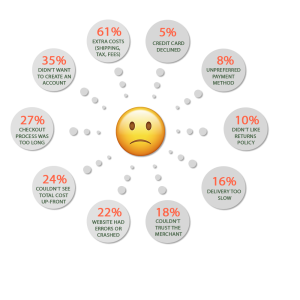Picture this: you’ve just enjoyed a sublime week’s holiday in the French Riviera, staying in a 5-star hotel. It was everything that you expected: classy, indulgent, relaxing.
When you check-out and are settling up, you are told that the card machine is malfunctioning so you will have to pay by invoice. You’re told that check-out time is 11:00 am, and it’s now 11:04, so you will have to pay a late check-out fee. The concierge informs you that the taxi you ordered won’t be here for another half an hour, and due to the partnership between hotel and taxi company another one can’t be ordered.
These experiences could easily tarnish your memory of the end of your holiday. Will you return to this hotel after these annoying incompetencies have cropped up? Probably not…
Merchants often neglect the back-end of the customer experience, concentrating their efforts instead on the more immediate front-end experience and communicating the main selling points of their product. It’s difficult to blame them for this – each merchant is like a craftsman who wants to spend time and energy creating, marketing and selling their product or service. To ensure, however, that the customer experience is flawless throughout, attention needs to be paid to every step of the process.
E-commerce
Back-end customer experiences are particularly important for online businesses. Almost 70% of shoppers leave an ecommerce site without purchasing anything – despite putting items in their cart ready to purchase. Of these, 80% take place at the checkout and stem from the simple but avoidable frustration of being forced to enter delivery and payment details in slow and inefficient ways.
Reasons given for cart abandonment

If customers find themselves confused, annoyed or fatigued by a complicated or tiresome online checkout, they can simply click the cross in the top right-hand corner of the window and, in a flash, the online shop is sent back into the deep recesses of the internet.
Crucially, for the merchant, the sale is lost.
Reducing customer drop-off at the checkout isn’t rocket science, but unless merchants put in place impactful measures, the effects can be devastating. Here are some key tips to keep customers focused and motivated when buying online:
1. Supply one-click shortcuts
Try to make the payment process as quick and efficient as possible. Use auto-fill for addresses, then let customers save these, along with their card details, for a faster checkout next time. Another key way to speed up the checkout is by offering alternative payment methods like Paypal and Alipay.
2. Be upfront about delivery costs and timescales
An estimated 36% of shoppers abandon their online shopping because of unexpected delivery costs. Keep your customers informed of how and when the goods will be delivered, and make sure that the costs incurred do not come as an unpleasant surprise.
3. Offer a guest checkout
Insisting that a customer sets up an account can discourage them if they’re pushed for time; you may want their contact details for future communications, but this is worthless unless they actually decide to go through with the purchase.
4. Enable social log-ins
The average UK consumer has 118 online accounts. By using a social medium such as Facebook or Google to log in, you can bypass a long registration process, and the customer will have one less username and password to remember.
5. Display a progress bar
Sometimes the various stages of an online purchase can feel like a decathlon; keep the finishing line in sight for your customer so that they know how long the process will take, and won’t become disillusioned with the process.
6. Highlight errors in forms
Avoid incurring the wrath of your customer who can’t find an error in the information they’ve submitted by clearly highlighting the fields that need attention.
7. Ensure it’s easy to edit what’s in the basket
Customers often want to chop and change the contents of their basket; by providing a system that facilitates this, unnecessary angst can be avoided.
8. Make it clear how to get in touch
Should a customer need to get in touch to resolve a problem that they’re experiencing during their purchase, it’s important to have support close at hand. Clearly providing an email is good, but offering a telephone number or live chat is even better.
9. Save abandoned carts
If for whatever reason the purchase cannot be completed, the customer may come back at a later stage. If this is the case, it’s helpful for them to have the items retained in the basket for a quick, simple shopping experience.
10. Trigger browsing and cart abandonment emails
External distractions may mean that potential customers are unable to complete their purchase, and may temporarily forget about the product or service that you’re offering. By gently reminding them of their past searches and browsing history, you can help customers to get back on track with the purchase.
Transparency and simplicity
Why do people tend to shop online? Because it’s quicker and easier. If a customer is faced with a virtual assault course before the purchase can be completed, they may ask themselves: why bother?
Take note: engineer your payment pages to be frictionless, so that the customer will breeze through, the purchase will be made, and the profit will be sitting snugly in your pocket.
Trust Payments have nearly 20 years of experience in helping merchants to create flawless payment pages. We take care of the complete payment experience to minimise the risk of customer drop-off and cart abandonment.





